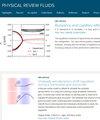致密双分散粒状剪切流中的反面离析和扩散
IF 2.5
3区 物理与天体物理
Q2 PHYSICS, FLUIDS & PLASMAS
引用次数: 0
摘要
许多致密颗粒系统都是非单分散的,由不同大小的颗粒组成,在流动过程中会根据大小发生分离。这种现象是许多工业和地球物理过程的一个重要方面,需要建立预测性连续模型。本文系统地研究了流动、致密、双分散粒状混合物中偏析和扩散三维性质的一个关键方面,即沿垂直于剪切平面方向的偏析和扩散作用,我们将其称为偏析和扩散的反平面模式。为此,我们采用离散元素法(DEM)模拟了摩擦球双向分散的致密混合物在理想化配置下的流动,该配置隔离了反平面偏析和扩散。我们发现,根据 DEM 模拟结果校准的先前开发的构成方程无法捕捉到反平面偏析动力学的各个方面,而偏析和扩散过程均发生在剪切平面内。因此,我们利用 DEM 模拟结果,为反面模式的偏析和扩散通量提供信息,并校准其构成方程。在改变剪切应变率和混合物成分等参数的同时,我们还根据不同情况下的其他 DEM 模拟结果,测试了由此产生的反面偏析动力学连续模型的预测结果,结果发现校准后的模型预测结果与 DEM 模拟结果非常吻合。最后,我们提出了一种对偏析和扩散通量的构成形式进行概括的策略,以获得同时考虑偏析和扩散过程的平面内和反面模式的三维构成方程。本文章由计算机程序翻译,如有差异,请以英文原文为准。

Anti-plane segregation and diffusion in dense, bidisperse granular shear flow
Many dense granular systems are non-monodisperse, consisting of particles of different sizes, and will segregate based on size during flow. This phenomenon is an important aspect of many industrial and geophysical processes, necessitating predictive continuum models. This paper systematically studies a key aspect of the three-dimensional nature of segregation and diffusion in flowing, dense, bidisperse granular mixtures—namely, segregation and diffusion acting along the direction perpendicular to the plane of shearing, which we refer to as the anti-plane modes of segregation and diffusion. To this end, we consider discrete-element method (DEM) simulations of flows of dense, bidisperse mixtures of frictional spheres in an idealized configuration that isolates anti-plane segregation and diffusion. We find that previously developed constitutive equations, calibrated to DEM simulation results from flows in which both the segregation and diffusion processes occur within the plane of shearing, do not capture aspects of the anti-plane segregation dynamics. Accordingly, we utilize DEM simulation results to inform and calibrate constitutive equations for the segregation and diffusion fluxes in their anti-plane modes. Predictions of the resulting continuum model for the anti-plane segregation dynamics are tested against additional DEM simulation results across different cases, while parameters such as the shear strain rate and mixture composition are varied, and we find that the calibrated model predictions match well with the DEM simulation results. Finally, we suggest a strategy for generalizing the constitutive forms for the segregation and diffusion fluxes to obtain three-dimensional constitutive equations that account for both the in-plane and the anti-plane modes of the segregation and diffusion processes.
求助全文
通过发布文献求助,成功后即可免费获取论文全文。
去求助
来源期刊

Physical Review Fluids
Chemical Engineering-Fluid Flow and Transfer Processes
CiteScore
5.10
自引率
11.10%
发文量
488
期刊介绍:
Physical Review Fluids is APS’s newest online-only journal dedicated to publishing innovative research that will significantly advance the fundamental understanding of fluid dynamics. Physical Review Fluids expands the scope of the APS journals to include additional areas of fluid dynamics research, complements the existing Physical Review collection, and maintains the same quality and reputation that authors and subscribers expect from APS. The journal is published with the endorsement of the APS Division of Fluid Dynamics.
 求助内容:
求助内容: 应助结果提醒方式:
应助结果提醒方式:


